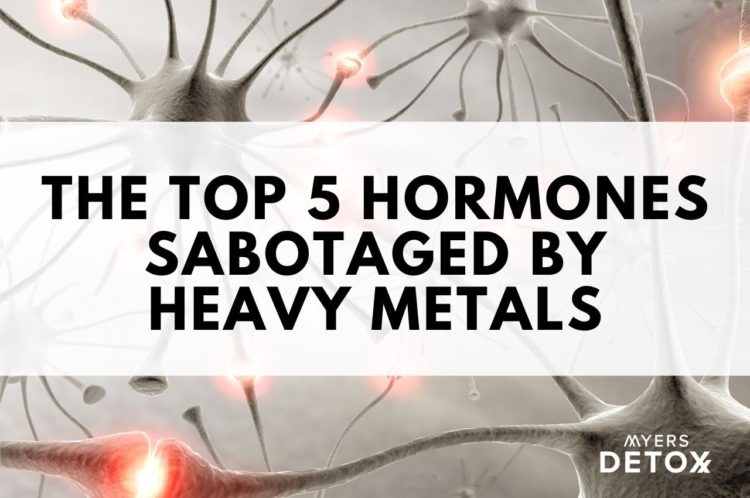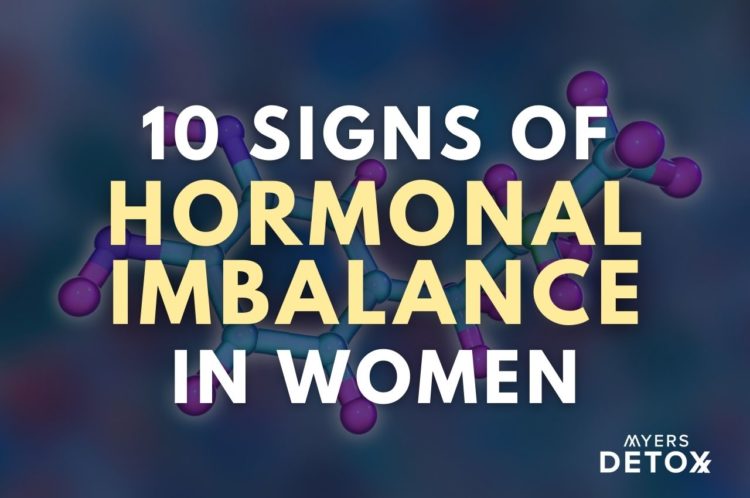The Top 5 Hormones Sabotaged by Heavy Metals

Hormonal balance is one of the most crucial aspects of your overall health. When your hormones are out of whack, every other system in your body can be affected – your weight, your mood, early onset menopause, and much more.
Unfortunately, in our modern environment, it’s impossible not to come into contact with toxic compounds that target your hormones.
One of the biggest offenders? Heavy metals.
In this article, you’ll learn:
- How heavy metals act like hormones in your body
- Surprising ways you’re exposed to heavy metals
- The detrimental impact heavy metals have on your sex hormones like estrogen, testosterone and progesterone
- How heavy metals negatively impact your thyroid (and why so many are suffering from poor thyroid function)
- How heavy metals impact insulin and blood sugar control (and your weight)
- The first crucial step you can take in reclaiming your hormone balance
What Are Hormones?
Hormones are chemical messengers that your body releases into your blood (usually from endocrine glands) that send signals to other parts of your body. In other words, your hormonal system is a way for different parts of your body to communicate with each other.
Hormones can be used to communicate between endocrine glands, creating a signaling cascade for the production of new hormones. They can also be used to communicate from an endocrine gland to a target organ.
This interplay between hormones, endocrine glands, and target organs is called your endocrine system. Your endocrine system is a complex and vital operation that affects a myriad of physiological activities, including growth and development, metabolism, weight, fertility, and more[1].
How You’re Exposed To Heavy Metals
Heavy metals are toxic pollutants that are ubiquitous in our environment. No matter how clean you eat, how careful you are to use non-toxic personal care products, and how aware you are of potential toxins in your drinking water — heavy metal ingestion is impossible to avoid.
The use of heavy metals for industrial, medical, agricultural, and technological purposes has perpetuated intensive mining of them for use in manufacturing [2]. Thus, there is far more of these toxins in our air, food and water than at any time in recorded history.
Some common ways that you may be exposed to heavy metals include:
- Personal care products
- Soil
- Paint
- Drinking water
- Food
- Supplements
- Spices
- Medication
- Air pollution
- Cooking utensils
- Food containers
- Home renovations
How Heavy Metals Impact Hormones
Once you become exposed to heavy metals, they can cause havoc on every aspect of your hormonal system. The delicate balance of your hormones is what makes the human body so fascinating, but also creates a great deal of vulnerability when this system goes out of whack.
While each heavy metal can impact your hormones in unique ways, there are three primary mechanisms by which metals throw your hormones out of balance.
#1 They Accumulate In Vital Organs and Glands
Heavy metals can accumulate in your body in various organs and glands. They can accumulate in your thyroid, your ovaries, your adrenals and wreak havoc with the gland’s function. When they target endocrine glands, it can cause direct dysfunction to the production of hormones.
This dysfunction can show up as underproduction, overproduction, or complete inhibition of hormones. They also mess with the tight feedback loop that your glands rely on to know when and how much of a particular hormone to produce[3].
#2 They Can Act As Hormones
Some heavy metals can act like hormones, a phenomenon known as hormone-mimicking. When this happens, heavy metals can block the receptor sites that your hormones normally activate, resulting in either overactivation of the receptor or inhibition[4].
#3 They Poison Enzymes Responsible For Hormone Production
Some hormones are used as precursors to other hormones. For instance, DHEA is a hormone that acts as a precursor to testosterone and estrogen. In order for DHEA to convert into other hormones, however, it needs a type of enzyme called hydroxylase.
Heavy metals can target and poison hydroxylase enzymes, rendering them useless in the conversion of one hormone to another[5]. This results in lower hormone production and is one of the top ways that metals poison hormone production.
Individual Hormones and Heavy Metals
Let’s take an in-depth look at how heavy metals impact some of your most vital hormonal systems, including:
- Thyroid Hormones
- Sex Hormones like estrogen, testosterone and progesterone
- Stress hormones like adrenaline and cortisol
- Insulin
How Heavy Metals Impact Thyroid Hormones
Your thyroid takes orders from your pituitary gland, which is located at the bottom of your brain. Your pituitary sends out a hormone called thyroid stimulating hormone (TSH), which tells you thyroid gland how much thyroid hormone to produce and secrete.
Your thyroid produces two hormones — thyroxine (also called T4), and triiodothyronine (also called T3). T4 is mostly inert until enzymes transform it into the highly active T3 hormone. Generally, about 80% of the thyroid hormones released are in the T4 form, with 20% coming from T3.
Your thyroid is essential for the maintenance of your metabolism. Specifically, it controls your metabolic rate, heart, muscles, digestive function, brain development, and bone health[6].
Imbalances can occur with your thyroid leading to a range of symptoms, depending on whether the thyroid becomes overactive (hyperthyroid), or underactive (hypothyroid). In the case of an overactive thyroid, your body goes on overdrive, pushing your metabolic rate out of its comfort zone and creating unrest physically and emotionally.
In hypothyroidism, everything slows down to a snail-like pace. Your metabolism goes on vacation, and both your mind and body become sluggish.
Symptoms of an overactive thyroid include[7]:
- Weight loss
- Anxiety
- Rapid heartbeat
- Irregular heartbeat
- Nervousness, anxiousness, irritability
- Tremors
- Goiter (enlarged thyroid gland)
- Sensitivity to heat
- Muscle weakness
- Difficulty sleeping
- Thinning hair
- Sweating
- Irregular periods
Symptoms of an underactive thyroid include[8]:
- Fatigue
- Constipation
- Elevated blood cholesterol
- Pain, stiffness, and swelling in joints
- Weight gain
- Puffy face
- Dry skin
- Thinning hair
- Irregular periods
- Slowed heart rate
- Depression
- Impaired memory
- Brain fog
- Enlarged thyroid gland (goiter)
An imbalance in your thyroid hormones, whether hyperactive or hypoactive, can be anywhere from uncomfortable to debilitating. So how do heavy metals in the environment mess with the function of this essential gland?
The three metals that specifically attack your thyroid are cadmium, nickel, and mercury.
Research shows that exposure to mercury can result in not only hypothyroidism but thyroid autoimmune conditions as well [13][9].
Mercury interferes with the thyroid on 4 levels:
1 – Thyroid – Mercury has a high affinity for your thyroid gland. It not only stores in this precious gland, but it also takes the place of iodine — which is a crucial component to thyroid hormone production. Your thyroid hormones are made of iodine.
2 – Pituitary – the pituitary gland signals to the hypothalamus to make more TSH. Mercury interferes with the feedback loop from T4 back to the pituitary cells that regulates TSH synthesis.
3 – Hypothalamus. Mercury can deposit in the hypothalamus. When this happens, TSH manufacture can be inhibited. Additionally, TRH – thyrotropin releasing hormone – is manufactured in the hypothalamus. Mercury can deposit in the thyrotropes that manufacture TSH. TSH manufacture is then inhibited and less can be produced.
Mercury interferes in signaling and the cells themselves by interfering in the delicate feedback loop that converts T4 to T3 and then the signal communicating back to the hypothalamus.
4 – Blood – it inhibits the conversion of Free T4 to Free T3 in blood. Mercury poisons enzymes like DI Autonasers that convert Free T4 to T3 in blood circulation.
Cadmium is stored in your pituitary gland — the master gland that signals your thyroid to produce its hormones. Research shows that cadmium exposure can increase the production of both T4 and T3, interrupting the natural hormonal balance[9].
Interestingly, some research shows that in men, cadmium may have the opposite effect — inhibiting thyroid function and contributing to hypothyroidism[10].
Nickel has been indicated in Chronic Autoimmune Thyroiditis (CAT), also known as Hashimoto’s disease. Hashimoto’s is an autoimmune disorder in which your immune system attacks your thyroid gland, damaging it so that it cannot produce adequate hormones, resulting in hypothyroidism[11][12].
Mercury induces Hashimoto’s. Depending upon one’s genetics, people can develop antibodies to different types of mercury, including inorganic mercury from mercury fillings or methylmercury from fish. You can find antibodies to one or all of the above with metal antibodies testing. Most commonly mercury can induce antithyroglobulin antibodies involved in Hashimoto’s, but can also induce the antibodies that cause Grave’s disease.
Hashimoto’s doesn’t always induce hypothyroidism or low thyroid hormones. You can get Hashimoto’s apart from hypothyroidism and still have a reasonable production of hormones. You can have antibodies attacking your thyroid yet have normal production of T3 and T4 if you have hashimoto’s.
However, 5-10 years down the road, you’re almost always going to manifest lowered hormone production. This is why it’s important that you do a full thyroid panel, including thyroid antibodies, whenever you do a physical with your doctor.
How Heavy Metals Affect Sex Hormones
Your sex hormones play an essential role in sexual health and development. They regulate your monthly cycles (and yes, men have a cycle too), and ensure that your sexual organs are functioning properly.
Unfortunately, sex hormones can take a huge hit from even low level heavy metal exposure (not to mention plastics and chemicals). This can result in a wide range of hormonal imbalances that can show up anywhere between mild to quite severe. Let’s dive into three sex hormones that take the brunt of the hit from heavy metals: estrogen, progesterone, and testosterone.
Estrogen
Estrogen is the primary female hormone as it is responsible for the normal sexual and reproductive development in women. Estrogen is primarily secreted from your ovaries. However, your adrenal glands and fat cells also produce small amounts of estrogen. It’s important to note that while estrogen is the primary female sex hormone, men also have estrogen as part of their hormonal makeup.
Some of the roles that estrogen plays in your body include[14]:
- Growth of breasts
- Start of menstrual cycle
- Growth of pubic and armpit hair
- Protects the health of your bones
- Stabilizes mood
- Protects your bones, heart, skin, and other tissues
Estrogen imbalances occur more often in women than men but can affect both sexes. Some symptoms of estrogen imbalance include:
- Heavy periods
- Irregular periods
- Hot flashes
- Night sweats
- Constipation or diarrhea
- Acne
- Breast tenderness
- Anxiety and panic attacks
- Weight gain or loss
- Fatigue
- Poor Sleep
- Memory problems
The primary heavy metals that affect estrogen are mercury, cadmium, lead, and nickel.
These metals have been found to decrease natural estrogen production and may even mimic the effects of estrogen in your body. Estrogen mimicking compounds can bind to the estrogen receptors in your body and activate pathways in a similar way to estrogen. This becomes a problem when there is overactivation, and can even create a negative feedback loop that tells your body to create less estrogen[15].
Research shows that mercury exposure, due to its interference in sex hormones, can cause issues with fertility (both male and female), pregnancy outcome, menstrual cycles, and may lead to congenital deficits[16].
High levels of lead have also been shown to increase estrogen in a similar way to mercury[17]. However, there is animal research which shows that lead may also inhibit estrogen, potentially leading to infertility due to its harmful impact on the uterus[18].
Both nickel and cadmium are considered metalloestrogens, which are metals that act as estrogens in your body — docking to and blocking estrogen receptors and masquerading as the hormone[19].
Research shows that nickel and cadmium toxicity may be indicated in an estrogen-dominant disorder called endometriosis. Endometriosis is a painful disorder that occurs when tissue similar to your uterine tissue grows outside of your uterus. This can cause severe pain as this tissue behaves like uterine tissue and follows a monthly cycle of thickening and breaking down with your period[20].
Endometriosis is marked by increased levels of estrogen, which may provide insight into how nickel and cadmium play a role in this unfortunate condition[21][22].
Testosterone
Testosterone is the primary male sex hormone, but much like estrogen, this hormone is found in both men and women. In males, testosterone is produced in the testes via signals from the pituitary gland. In women, testosterone is produced in the ovaries and the adrenal gland. Some of the function of testosterone include[23]:
- The development of the penis and testes
- Deepening of the voice during puberty
- Development of facial hair during male puberty
- Muscle growth and strength
- Bone growth and strength
- Sex drive
- Sperm production
When testosterone is low in adolescents, it can affect the normal development of sexual organs and alter puberty. Likewise, high levels of testosterone can lead to issues like acne and low sperm count.
Some symptoms associated with testosterone imbalance include[23]:
Low testosterone:
- Loss of muscle mass
- Increased breast size
- Low libido
- Impotence
- Irritability
- Depression
- Poor concentration
- Low motivation
- Brittle bones
- Loss of body hair
High Testosterone:
- Low sperm count
- Insomnia
- Headaches
- Stunted growth
- Aggressive behavior
- Mood swings
- Impaired judgment
- Delusions
- Weight gain
- Acne
- Prostate enlargement
- Liver disease
- Heart muscle damage
The Heavy Metals That Impact Hormones
The primary heavy metals impacting testosterone production are lead, arsenic, cadmium, and mercury.
Mercury toxicity has been indicated in the hormonal disorder PCOS (polycystic ovarian syndrome), which is marked by high testosterone levels, indicating that mercury may increase testosterone production. On the other hand, animal research shows that mercury toxicity may reduce the production of testosterone as well, reducing the ability for animals to reproduce[24][25].
High levels of cadmium in the blood are associated with reduced levels of testosterone. Some research shows that cadmium has a direct effect on the testes, reducing their function and subsequently inhibiting testosterone production[26][27]. Cadmium is primarily acquired in cigarette smoke, second hand smoke, marijauna smoking, air pollution and fish and shellfish.
Arsenic exposure has been linked to reproductive and fertility issues in men due to its inhibitory effect on testosterone production. In fact, some research suggests that arsenic exposure may be at the root of some cases of erectile dysfunction (ED)[28][29].
High levels of lead have also been shown to inhibit testosterone production in some studies, while other reports show that lead may increase testosterone along with the risk for liver cancer[30][31].
Progesterone
Progesterone plays a crucial role in your menstrual cycle and reproductive processes. It’s secreted by the ovaries after ovulation, during the second half of your menstrual cycle, to prepare your endometrium for the potential of pregnancy. Here, it triggers the thickening of your endometrial lining to accept a fertilized egg[32].
Symptoms of progesterone imbalance include[32]:
- Abnormal uterine bleeding
- Irregular periods
- Missed periods
- Spotting
- Spotting during pregnancy
- Miscarriages
- Fibroids
- Weight gain
- Decreased sex drive
- PMS
- Mood swings
The primary heavy metals that can interfere with progesterone are copper, lead, and cadmium.
While many women swear by their copper IUDs, some research shows that copper can change the structure of the endometrium, decreasing the number of progesterone receptors available[33].
Lead may have a dynamic effect on progesterone levels as some research shows that it can inhibit the production of progesterone, while other studies show a correlation between lead exposure and increased progesterone[34][15].
Cadmium is one of the worst offenders when it comes to the female reproductive system. Research shows that it can disrupt the synthesis of progesterone by interfering with the activity of pregnenolone (a precursor to progesterone)[35]. Cadmium can also be the culprit behind repeat miscarriages.
Prolactin
Prolactin is a hormone that’s primarily responsible for the production of breast milk. This hormone causes your breasts to grow and develop, and eventually provide milk once a baby is born.
While its main function is in breast milk production, this hormone is found in both men and women, and it can affect the function of other sex hormones as it is intimately tied to your entire hormonal system.
Some symptoms of prolactin imbalance include[36]:
- Unwanted lactation
- Estrogen deficiency
- Menstrual disturbances
- Testosterone deficiency
- Sexual problems
- Insufficient milk supply
Lead has been shown to reduce prolactin’s blood levels, resulting in a reduction of breast milk production[37].
Cadmium, on the other hand, may have a dynamic effect on prolactin, either increasing or decreasing production, depending on the situation. Research shows that cadmium, as an estrogen-mimicking compound, can stimulate the release of prolactin and increase its production[38].
Conversely, laboratory studies show that prolactin release is inhibited after cells are treated with cadmium. This could point to several mechanisms by which this heavy metal disrupts the typical behavior of prolactin[39].
Heavy Metal Effects on Stress Hormones and the Adrenal Glands
Your stress hormones have a survival function – to keep you in alive when you experience stressful events. Chronic stress, which most people are experiencing today, can put you at risk for a host of health issues, so your stress hormone system’s proper function is crucial for maintaining longevity[40]. Heavy metals play a role in your stress hormone system not functioning and reacting properly.
Cortisol
Cortisol is your primary stress hormone. It’s that get up and go hormone that gets you out of bed and excited about your day. It’s secreted from your adrenal glands in response to a threat in your environment. This natural response is an adaptive mechanism to keep you alert and ready to go in the case of a life-threatening situation.
When cortisol is released, it increases the glucose in your blood, so you have fuel to run, and suppresses functions like digestion and immunity that aren’t essential when you’re under the threat of attack[40].
Research shows that cortisol levels are inversely related to exposure of both nickel and aluminum. The higher the nickel or aluminum, the lower the cortisol levels. This means that toxicity of these metals could impair your body’s ability to deal with stressors in your environment.
Conversely, cadmium seems to increase cortisol concentrations, which could put your nervous system into overdrive and may even lead to adrenal fatigue[41][42]. Interestingly enough, coffee can have varying levels of cadmium. It’s this cadmium, in addition to caffeine, that gives coffee its kick (increased cortisol).
Norepinephrine and Epinephrine
Norepinephrine and epinephrine are two more stress hormones released by your adrenal glands. Epinephrine (also known as adrenaline) and norepinephrine (also called noradrenaline) work together to increase your heart rate and blood pressure, and break down fat to supply your body with fuel in a stress response.
Norepinephrine also plays a role as a neurotransmitter affecting mood and your sleep-wake cycle. Epinephrine, on the other hand, triggers your fight or flight response and triggers blood vessels to contract and redirect toward major muscle groups (so you can flee faster)[43][44].
Symptoms of imbalanced norepinephrine include[44]:
- Depression
- Anxiety
- Post-traumatic stress disorder
- Substance abuse
- Euphoria
- Panic attacks
- Lethargy or hyperactivity
- ADHD
- Elevated blood pressure
Symptoms of imbalanced epinephrine include[43]:
- Anxiety
- Weight loss
- Rapid heartbeat
- Palpitations
- High blood pressure
Chronic exposure to cadmium has been shown to disrupt the normal activity of your adrenal glands. As a result, this can decrease the serum levels of norepinephrine and epinephrine. Since these two hormones have such a close relationship with cortisol, this may also result in an imbalance and cortisol and, ultimately, your entire stress response[45][46].
Aldosterone
Aldosterone plays a crucial role in the regulation of blood pressure by controlling the amount of sodium and potassium in your bloodstream. It’s also essential for balancing your body’s pH and electrolyte levels.
Symptoms of aldosterone imbalance include:
- High blood pressure
- Low potassium levels
- An abnormal increase in blood volume
- Low blood pressure
- Increased potassium levels
- Lethargy
Research shows that chronic exposure to cadmium can disrupt adrenal gland function and increase aldosterone, thereby increasing potassium and sodium levels. This could result in dysfunction in both electrolytes and blood pressure and potentially lead to issues with your heart[47][45].
How Heavy Metals Affect Insulin
Insulin is a hormone produced by your pancreatic cells that’s essential in controlling your blood sugar levels. After you eat a meal, insulin is stimulated and released from your pancreas to shuttle glucose out of your blood and into your cells.
When your body doesn’t make enough insulin, or if your cells become desensitized to this hormone, it can result in diabetes[48].
Symptoms of insulin imbalance [49]:
- Diabetes
- High blood sugar
- Low blood sugar
- Hot flashes
- Fatigue
- Weight gain
- Confusion
- Dizziness
- Brain fog
- High blood pressure
I believe heavy metals and toxins to be the primary driver of diabetes and poor blood sugar control and insulin resistance.
There are several research papers that explore the link between heavy metal toxicity and the incidence of insulin resistance and type two diabetes. As toxicity in our environment has grown, increasing numbers of individuals continue to trend towards obesity and type two diabetes[50][51].
Research shows that chronic low-level cadmium exposure can impair the function of insulin-secreting beta cells in your pancreas. These cells are crucial for hormonal production and blood sugar balance, and therefore cadmium exposure may be associated with type two diabetes[52].
Arsenic is another metal that’s been studied for its potential role in the development of diabetes. Several studies have shown a positive association of arsenic exposure and the inhibition of insulin secretion from pancreatic cells.
One primary route of exposure for arsenic is through tainted drinking water, and researchers attest that if environmental regulations around drinking water were more strict, we might see a decline in arsenic toxicity[53][54].
How To Test For Heavy Metals
There are several testing options out there for heavy metals, but my go-to is always a hair mineral analysis. The reason for this is two-fold; a hair mineral analysis is not only the cheapest option for testing heavy metals, but it’s also incredibly accurate.
What’s more, using a hair mineral analysis allows you to determine:
- Heavy metal levels
- Hidden heavy metals level not readily apparent by the test (I have a way to read between the lines to determine metal levels that are then corroborated on urine or stool metals tests)
- Mineral deficiencies
- Mineral toxicities
- Adrenal functioning (stress)
- Liver and kidney functioning
- Carbohydrate tolerance
- Cortisol and stress hormone indicators
- Inflammation
- Thyroid function
- Nervous system imbalances
- Metabolic rate
A Hair Mineral Analysis is a great screening tool. All of these factors come together to paint a picture of health imbalances you may have. Even more importantly, however, they can give you insight into how to best move forward with a customized detox towards optimizing your health and hormones.
Since heavy metals toxicity does not happen in a vacuum, you can be sure that if your hormones are being impacted, other areas of your body are also taking a hit. With a hair mineral analysis, you can get the big picture view of what’s really happening in your body.
Click Here for References+
- https://www.yourhormones.info/hormones
- Tchounwou, Paul B., et al. “Heavy metal toxicity and the environment.” Molecular, clinical and environmental toxicology. Springer, Basel, 2012. 133-164.
- Singh, Reena, et al. “Heavy metals and living systems: An overview.” Indian journal of pharmacology 43.3 (2011): 246.
- Zang, Yu, Shelly Odwin-DaCosta, and James D. Yager. “Effects of cadmium on estrogen receptor mediated signaling and estrogen induced DNA synthesis in T47D human breast cancer cells.” Toxicology letters 184.2 (2009): 134-138.
- Tsang, Sophia, and A. Furst. “In vitro inhibition of aryl hydrocarbon hydroxylase by heavy metals.” Oncology 33.5-6 (1976): 201-204.
- https://www.yourhormones.info/glands/thyroid-gland/
- https://www.mayoclinic.org/diseases-conditions/hyperthyroidism/symptoms-causes/syc-20373659
- https://www.mayoclinic.org/diseases-conditions/hypothyroidism/symptoms-causes/syc-20350284
- Chen, Aimin, et al. “Thyroid hormones in relation to lead, mercury, and cadmium exposure in the National Health and Nutrition Examination Survey, 2007–2008.” Environmental health perspectives 121.2 (2013): 181-186.
- Chung, Seung Min, et al. “Sex-specific effects of blood cadmium on thyroid hormones and thyroid function status: Korean nationwide cross-sectional study.” Journal of Trace Elements in Medicine and Biology 53 (2019): 55-61.
- https://www.niddk.nih.gov/health-information/endocrine-diseases/hashimotos-disease
- Andrioli, Massimiliano, et al. “Systemic nickel allergic syndrome as an immune-mediated disease with an increased risk for thyroid autoimmunity.” Endocrine 50.3 (2015): 807-810.
- https://symbiosisonlinepublishing.com/thyroid-disorders-therapy/thyroid-disorders-therapy03.php
- https://academic.oup.com/jcem/article/99/4/31A/2537122
- Pollack, Anna Z., et al. “Cadmium, lead, and mercury in relation to reproductive hormones and anovulation in premenopausal women.” Environmental health perspectives 119.8 (2011): 1156-1161.
- Bjørklund, Geir, et al. “Mercury exposure and its effects on fertility and pregnancy outcome.” Basic & Clinical Pharmacology & Toxicology 125.4 (2019): 317-327.
- Pollack, Anna Z., et al. “Cadmium, lead, and mercury in relation to reproductive hormones and anovulation in premenopausal women.” Environmental health perspectives 119.8 (2011): 1156-1161.
- Tchernitchin, Nina N., et al. “Effect of chronic exposure to lead on estrogen action in the prepubertal rat uterus.” Environmental Toxicology: An International Journal 18.4 (2003): 268-277.
- Aquino, Natalie B., et al. “The role of cadmium and nickel in estrogen receptor signaling and breast cancer: metalloestrogens or not?.” Journal of Environmental Science and Health, Part C 30.3 (2012): 189-224.
- https://www.mayoclinic.org/diseases-conditions/endometriosis/symptoms-causes/syc-20354656
- Yuk, Jin-Sung, et al. “Nickel allergy is a risk factor for endometriosis: an 11-year population-based nested case-control study.” PloS one 10.10 (2015): e0139388.
- Jackson, Leila W., Melissa D. Zullo, and J. M. Goldberg. “The association between heavy metals, endometriosis and uterine myomas among premenopausal women: National Health and Nutrition Examination Survey 1999–2002.” Human reproduction 23.3 (2008): 679-687.
- https://www.health.harvard.edu/drugs-and-medications/testosterone–what-it-does-and-doesnt-do
- Heath, John C., et al. “The effects of chronic ingestion of mercuric chloride on fertility and testosterone levels in male Sprague Dawley rats.” Journal of Biomedicine and Biotechnology 2012 (2012).
- Merlo, Eduardo, et al. “Mercury leads to features of polycystic ovary syndrome in rats.” Toxicology letters 312 (2019): 45-54.
- Waalkes, Michael P., Sabine Rehm, and Debbie E. Devor. “The effects of continuous testosterone exposure on spontaneous and cadmium-induced tumors in the male Fischer (F344/NCr) rat: loss of testicular response.” Toxicology and applied pharmacology 142.1 (1997): 40-46.
- Chen, Chi, et al. “Blood cadmium level associates with lower testosterone and sex hormone-binding globulin in Chinese men: from SPECT-China study, 2014.” Biological trace element research 171.1 (2016): 71-78.
- Kim, Yoon-Jae, and Jong-Min Kim. “Arsenic toxicity in male reproduction and development.” Development & reproduction 19.4 (2015): 167.
- Freeman, Kris. “Arsenic and erectile dysfunction: drinking contaminated well water increases risk.” (2008): A172-A172.
- Chen, Chi, et al. “Associations of blood lead levels with reproductive hormone levels in men and postmenopausal women: Results from the SPECT-China Study.” Scientific reports 6 (2016): 37809.
- Aminian, Omid, et al. “Relationship between blood lead level and male reproductive hormones in male lead exposed workers of a battery factory: A cross-sectional study.” Iranian Journal of Reproductive Medicine 11.8 (2013): 673.
- https://www.hormone.org/your-health-and-hormones/glands-and-hormones-a-to-z/hormones/progesterone
- De Castro, A., et al. “The effect of copper ionsin vivo on specific hormonal endometrial receptors.” Advances in contraception 2.4 (1986): 399-404.
- Sierra, Evelyn M., and Evelyn Tiffany-Castiglioni. “Effects of low-level lead exposure on hypothalamic hormones and serum progesterone levels in pregnant guinea pigs.” Toxicology 72.1 (1992): 89-97.
- Zhang, Wenchang, and Haimei Jia. “Effect and mechanism of cadmium on the progesterone synthesis of ovaries.” Toxicology 239.3 (2007): 204-212.
- https://www.hormone.org/your-health-and-hormones/glands-and-hormones-a-to-z/hormones/prolactin
- Takser, Larissa, Donna Mergler, and Julie Lafond. “Very low level environmental exposure to lead and prolactin levels during pregnancy.” Neurotoxicology and teratology 27.3 (2005): 505-508.
- Ronchetti, Sonia A., et al. “Cadmium mimics estrogen-driven cell proliferation and prolactin secretion from anterior pituitary cells.” PLoS One 8.11 (2013): e81101.
- Winstel, Carol, and Phyllis Callahan. “Cadmium exposure inhibits the prolactin secretory response to thyrotrophin releasing hormone (TRH) in vitro.” Toxicology 74.1 (1992): 9-17.
- https://www.mayoclinic.org/healthy-lifestyle/stress-management/in-depth/stress/art-20046037
- https://www.hopkinsmedicine.org/health/conditions-and-diseases/overactive-adrenal-glands–cushings-syndrome
- Pérez-Cadahía, Beatriz, et al. “Relationship between blood concentrations of heavy metals and cytogenetic and endocrine parameters among subjects involved in cleaning coastal areas affected by the ‘Prestige’tanker oil spill.” Chemosphere 71.3 (2008): 447-455.
- https://www.hormone.org/your-health-and-hormones/glands-and-hormones-a-to-z/hormones/adrenaline
- https://www.hormone.org/your-health-and-hormones/glands-and-hormones-a-to-z/hormones/norepinephrine
- Gay, Flaminia, et al. “Chronic exposure to cadmium disrupts the adrenal gland activity of the newt Triturus carnifex (Amphibia, Urodela).” BioMed research international 2013 (2013).
- Ranabir, Salam, and K. Reetu. “Stress and hormones.” Indian journal of endocrinology and metabolism 15.1 (2011): 18.
- White, Perrin C. “Aldosterone: direct effects on and production by the heart.” The journal of clinical endocrinology & metabolism 88.6 (2003): 2376-2383
- https://www.hormone.org/your-health-and-hormones/glands-and-hormones-a-to-z/hormones/insulin
- https://www.diabetes.co.uk/insulin-resistance.html
- Rotter, Iwona, et al. “Relationship between the concentrations of heavy metals and bioelements in aging men with metabolic syndrome.” International journal of environmental research and public health 12.4 (2015): 3944-3961.
- Khan, Abdul Rehman, and Fazli Rabbi Awan. “Metals in the pathogenesis of type 2 diabetes.” Journal of Diabetes & Metabolic Disorders 13.1 (2014): 16.
- El Muayed, Malek, et al. “Accumulation of cadmium in insulin-producing β cells.” Islets 4.6 (2012): 405-416.
- Peng, Qing, Siobán D. Harlow, and Sung Kyun Park. “Urinary arsenic and insulin resistance in US adolescents.” International journal of hygiene and environmental health 218.4 (2015): 407-413.
- https://www.sciencedaily.com/releases/2018/01/180110163347.htm









